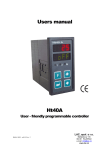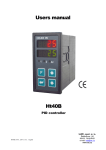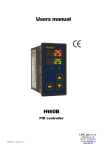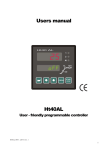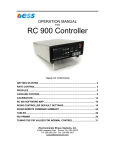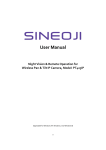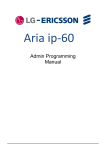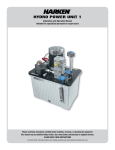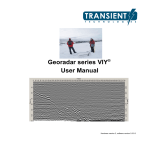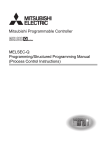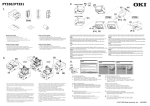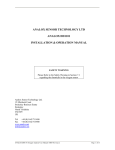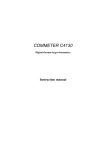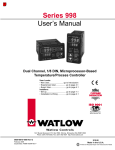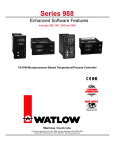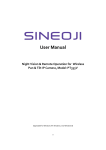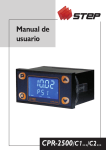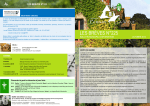Download Ht40T Users manual
Transcript
Users manual Ht40T PID controller with real-time clock HTH8 s.r.o. Ht40T, 09/03, soft 4.22/rev. 1 Eimova 880, 572 01 Polička Czech Republic tel.: +420 461 619 515 fax: +420 461 619 513 e-mail: [email protected] www.hth8.cz 1 1 Important Ht40T is a temperature/process controller intended for the built-in to panel. The format of the front frame is 96x48mm (1/8 DIN). The controller enables maintaining the set point value that is controlled with the real-time clock (e.g. 6:00 … 600 ºC, 8:00 … 900 ºC, 14:00 … 250 ºC ). The curve of the set point value can be set with the program separately for weekdays, Saturday and Sunday. The controller is factory equipped with 1input (temperature or process) and 3 outputs (control, signal and alarm). The controller is easy to run and operate. The set parameters can be locked and thus prevented from deleting by a user. User manual for the controller Ht40T is divided into the particular chapters. When you install and put into operation it is recommended to proceed in the following way: If you are a final user, the controller is in the default setting by the suplier If you are a final user, you will get the device in the customized setting and you can view and change only the parameters that you need for your own work on the controller. If you are a new user of the device, focus on the following chapters: • • • Basic terms, here it is explained the key functions, displays, and so on…. Basic mode, the description of basic mode of controller. Controlling of stp value, the ways of controlling of stp value. If you are carring out the complete installation and setting of the controller In this case you proceed in accordance with the following chapters: • Installation, in this chapter it is described how to build in a controller into panel. • Principals for installation, the sources of interference, we recommend you to observe the guidelines described in this chapter. • Wiring, the description for wiring of the controller. • Putting into operation, at first power-up you enter the initial menu in which you can configure and set the most important parameters of controller. According to the procedure you will perform installation, wiring and basic setting of controller. You can find out more details on the scope of the controller and its operation in the following chapters. For the users who have the controller completely set, we recommend to perform the setting of all the parameters in service level, menu ConF. Initial password for the entry to service level is set to 995. 2 2 Basic terms To avoid problems in operation of device the user should be able to manage its operation, setting parameters, ... 2.1 Operation and description of controller On the front panel board you can see 2 displays, 3 control lights (LED diodes) for indicating a status of outputs. The device is set and configured via 4 key-buttons. Function of indicators Upper display: • Indicates procees value in Basic mode • When you set, it shows parameter value Lower display: • Indicates stp value in Basic mode. • When you set, it shows the type of parameter LED diode „Al“ Indicates the state of alarm output LED diode „2“ Indicates the state of output 2 LED diode „1“ Indicates the state of output 1 Function of key-buttons The setting of parameters of the controller is performed via key-board. The function of each key-button is as follows: • , key for setting and viewing of parameters of user, operation, configuration and user level. By pressing this key you confirm the change in configured parameter and the controller comes to another parameter. • , key for decreasing a value of parameter. The value of parameter is either the figure or abbreviation composed of maximum 4 letters. • , key for increasing a value of parameter. • , key for setting of real-time clock. 2.2 Information and error messages Information and error messages are indicated only in basic mode, see page 5. Information messages, upper display • ---- … error of input sensor or input is not set. Information messages, lower display • • • • … starting autotunning of PID set 1, Pb1A ,It1A ,dE1A see page 11. … starting autotunning of PID set 2, Pb1b ,It1b ,dE1b see page 11. SP … the controller is set for controlling of stp value. CErr … Error of real-time clock. The controller maintains at idle (back-up) setpoint value. The error can be troubles hooted by setting of real-time clock. If the troubles persist, contact the supplier. Aut1 Aut2 3 Error messages, lower display If there is an error message indicated, then the control outputs are switched OFF, the signal output is switched OFF, the alarm output is activated. • Err0 … error in FLASH memory of program. Switch the controller OFF and ON again. If the problem persists, contact your supplier. • Err1 … error in EEPROM memory for configuration and operation parameters. The troubleshooting error can be made by restarting of all parameters in service level. After restart it is necessary to set up all parameters again. This can be done only by an experienced user. If the trouble persists, contact your supplier. • Err3 … error in A/D converter. It can be caused by electrical impulse at input, too low temperature and excessive humidity, … . Switch the controller OFF and ON again. If the problem persists, contact your supplier. 2.3 Overview of levels, menus For the right function of the controller it is necessary to set up its parameters properly. For better understanding the parameters are sorted out to groups (levels and menus). Level is superior to menu, menu is a part of level (menu out1). The structure of sorting shows the following picture. The program for the temperature curve You set the requested temperatures that will be maintained with the controller extra for weekdays, Saturday and Sunday. Setting of real-time clock You set the real-time clock. The access for setting of real-time clock can secured with the password. Double press for 3 seconds Choose requisite level by arrowkeys. oPEr x LEVL PASS ConF x LEVL PASS SErV x LEVL PASS If there is no password set for the particular level, parameter PASS will not apear. 4 Operation level The level where the operation parameters find themselves. Configuration level Is intended for the configuration of the controller.We recommend to secure this level with password. Service level Is intended for service level.We recommend to secure this level with password. 3 Basic mode The controller is in basic mode when powered up (the initial set-up must be performed, see page 25). On upper display the process value is shown, on lower display there is stp value shown. On upper display process value is shown On lower display stp value is shown • • • If there is a figure on lower display, the controller is in basic mode. If there is any heading on lower display, the controller is not in basic mode, parameters are set or viewed. In basic mode information and error messages are indicated on lower display, see page . Return to basic mode • • To return the controller to basic mode press shortly the keys . If there is no key pressed for 60 seconds, the controller itself returns to basic mode. 5 4 Controlling of stp value The controller can maintain stp value or stp value can be controlled with real-time clock acc. to the program you have set. 4.1 Controlling of stp value The controlling of stp value you set in operation level, parameter SP1C = SP. Stp value Process value You hange stp value via the arrow keys. ča On upper display process value is shown Lower display shows stp value and heading SP blinks. 25 SP 4.2 Program controlling with real-time clock The controller enables controlling of stp value with real-time clock, see the following picture. This type of controlling you set in operation level, parameter SP1C = ProG. You can set the curve for: • weekdays (Monday to Friday), • Saturday, • Sunday. SP 2 Stp value SP 1 Number of steps can be set, 1 to 10. SP 3 … tI 1 tI 2 tI 3 SP10 tI10 Time is set in hours and minutes. For example log 15.45 means 15 clock45 minutes. 6 time Editing a program To enter and scroll this menu press the key . If appears PASS on lower display, menu for editing a program is secured with the password. In this case set the proper password via the arrow-keys and confirm with the key again. Basic mode of controller d1-5 Setting program for weekdays (Monday to Friday). tI 1 SP 1 Yes tI 2 no … SP 2 tI10 SP10 d 6 tI 1 Set the program for Saturday. SP 1 Yes tI 2 no The number of steps in program can be limited in configuration level extra for weekdays, Saturday, Sunday. … SP 2 tI10 SP10 d 7 tI 1 Yes no SP 1 Set the program for Sunday. tI 2 … SP 2 tI10 SP10 You can set program for weekdays (d1-5), Saturday (d Stp value SP x 6) and Sunday (d 7). is set in measured units (for example ºC for temperature), time tI x in hour and minutes. How to limit the number of steps in program You can limit the number of steps of program configuration level, menu • C1-5 … you set the number of steps in program for weekdays, • C 6 … you set the number of steps in program for Saturday, • C 7 … you set the number of steps in program for Sunday. SYS, parameter: By limiting the number of steps the editing a program will be easier for you. 7 Response of controller to power cut-out when powered up When powered up (after power cut-out) the controller sets stp value of actual step.. When powered up again actual stp value is set to SP 2. SP 2 Stp value SP 1 SP 3 … tI 1 tI 2 tI 3 SP10 tI10 time Power cut-out Resuming of supply voltage Setting of more stp values for one time interval When you edit a program you can set more stp values for the same time. The controller accepts only the last stp value in this case. Example, you set: • tI 3 = 14.54, SP 3 = 450, • tI 4 = 14.54, SP 4 = 300, • tI 5 = 14.54, SP 5 = 100, The controller sets the last stp value for particular time, i.e. 100. Change of actual stp value When controlling with real-time clock you can change the actual stp value via arrow keys. The change of stp value must be allowed in configuration level, menu PASS, parameter P SP = oFF. Important: • • 8 The changed stp value is not edited to the program setting and after the power cut-out the stp value of actual step is set again. When the controller goes to the new step the stp value of the new step is set. 4.3 Setting of real-time clock To enter and scroll this menu press the key . If there is heading PASS on lower display, this menu is secured with the password. In this case set the proper password with the arrow-keys and confirm it with the key Display . Meaning YEAr Set the actual year. Mon Set the actual month. dAtE Set the actual date. hour Set the current clock. MIn Set the current minute. dAY Set the actual day (1 – Monday, 2 – Tuesday, … , 7 – Sunday). 9 5 Operation level In operation level you can set parameters which are available to a user. From basic mode to operation level you will get by pressing the keys LEVL, on upper display set oPEr and confirm with the key for 3 seconds. On lower display it appears . If PASS appears on lower display the level is secured with the password. In this case set the right password with the arrow-keys and confirm with the . PCn1 Aut SP1C SP ALhI out1 Pb1A It1A Yes dE1A no out2 Pb1b o2Lo Yes o2hI It1b dE1b no hYS1 Menu of operation level Display PCn1 Aut SP1C SP ALhI Meaning Shows the actual power of the output 1 in %. Starting / turning OFF of autotunning of PID parameters: • oFF, turning OFF of autotunning of PID parameters. • ht, starting of autotunning of PID parameters, heating. Controlling of stp value: • ProG, stp value is controlled by the program with help of real-time clock. • SP, the controller maintains stp value. Idle (back-up) stp value. The controller will switch over to this stp value only in case that real-time clock does not run or when the controller maintains stp value (SP1C = SP). Range: SP1L to SP1h. High limit of alarm. Alarm is activated, if process value is higher than the set limit. Range: - 499 to 2499 °C. out1, menu of parameters for the output 1 Menu is intended for manual setting of the control parameters of output 1 or for improving parameters when the controlling is not enough precise. To enter this menu set YES on upper display and confirm. Display Pb1A It1A dE1A Pb1b It1b dE1b hYS1 10 Meaning Proportional band of the output 1, the first set of PID parameters. Range: 1 to 2499 °C. Integral value of the output 1, the first set of PID parameters. Range: oFF, 0.1 to 99.9 minutes. Derivative value of the output 1, the first set of PID parameters. Range: oFF, 0.01 to 9.99 minutes. Proportional band, the second set of PID parameters. Range: 1 to 2499 °C. Integral value, the second set of PID parameters. Range: oFF, 0.1 to 99.9 minutes. Derivative value, the second set of PID parameters. Range: oFF, 0.01 to 9.99 minutes. Hysteresis of the output 1, this single parameter is set only for ON/OFF control. Range: 1 to 249 °C. out2, menu of parameters for the output 2 In menu there are the limits of signal output displayed (ot2 = SGPr or ot2 = SGdE). To enter menu set display and confirm. Display o2Lo o2hI YES on upper Meaning Low limit of signalling. The output is activated if process value is lower than the set limit. Range: • -499 to o2hI °C for ot2 = SGPr. • -999 to 0 °C for ot2 = SGdE. High limit of signalling. The output is activated if process value is greater than the set limit. Range: • o2Lo to 2499 °C for ot2 = SGPr. • 0 to 999 °C for ot2 = SGdE. 5.1 Parameters of the control output, PID controlling The controller Ht40T can be set to ON/OFF switching or PID controlling. The description of these principals for controlling you will find on page. Heating, ON/OFF switching ON/OFF switching is set with parameter ot1 = ht2. Parameter ot1 is found in configuration level, menu out1. In operation level you set hysteresis for ON/OFF switching, parameter hYS1. SP1 hYS1 Heating, PID controlling PID controlling for heating is set with parameter ot1 = ht. Parameter ot1 is found in configuration level, menu out1. In operation level you set PID parameters: • Pb1A, It1A, dE1A, If 1set of PID parameters is used (parameter ALGo). • Pb1A, It1A, dE1A, Pb1b, It1b, dE1b, If 2 sets of PID parameters are used. SP1 5.2 Automatic setting of PID parameters - autotunning The controller is equipped with the function for automatic setting of PID parameters – autotunning. Start of autotunning End of autotunning When in autotunning on lower display these headings blink: • Aut1 … controller sets parameters Pb1A, It1A, dE1A for heating. • Aut2 … controller sets parameters Pb1b, It1b, dE1b for heating. Procedure of starting autotunning: • • • • Automatic optimalization – autotunning you start with parameter Aut = ht (setting parameters for heating). Parameter Aut is found operation level. The control output must be set for PID controlling. The controller explores the characteristics of system from switching ON/OFF on the output and determines optimal PID parameters. It can cause an overshoot. When in autotunning on lower display information message (Aut1, Aut2) blinks. After the autotunning has been performed the parameters are written and information message stops blinking. 11 Important: • Parameters Pb1A, It1A, dE1A, are set when 1 set of PID parameters is used (ALGo = PId) or when 2 sets of PID parameters are used (ALGo = 2PId) and actual stp value is lower than parameter SPId. • Parameters Pb1b, It1b, dE1b, are set if stp value is higher than parameter SPId when 2 sets of PID parameters are used (ALGo = 2PId). Parameters ALGo and SPId are found in configuration level, menu out1. 5.3 Signal outputs The features of signal outputs are set in configuration level, menu out2. Limits for signalling o2Lo (low limit) and o2hI (high limit) are set in operation level, menu out2. Signalling is set in absolute values In configuration level, menu out2, set parameter ot2 = SGPr. Process value ON Signal output is turned ON if temperature is lower than o2Lo or higher than o2hI. OFF In configuration level, menu out2, you can set The active limits: • SId2 = both, both limits are active, • SId2 = hI, high limit is active, • SId2 = Lo, low limit is active. o2hI ON time o2Lo Signalling defined by the deviation from stp value In configuration level, menu out2, set parameter ot2 = SGdE. Signal limits are calculated from the deviation from stp value: • High limit of signalling = stp value + o2hI. • Low limit of signalling = stp value – o2Lo. o2hI Process value ON Stp value The features of signal output and setting of active limits are the same as in the previous example. OFF ON o2Lo time 5.4 Alarm output Alarm output is intended for the indication that process values exceeded the limit temperature set with the parameter ALhI. This parameter is found in operation level. If alarm is not active, relay is switched ON, if alarm is active, relay is switched OFF. Alarm is also activated when a sensor is broken and if there is a system error of controller. Process value Active Deactivated ALhI time 12 6 Configuration level Configuration level is intended for the basic setting of the controller. In this level the control output is turned OFF and alarm and signal outputs are deactivated. To enter configuration level from basic mode press both the keys for 3 seconds. On lower display it appears LEVL, on upper display set via the arrow-keys ConF and confirm. If PASS appears on lower display, configuration level is secured with the password. In this case set the password via the arrow-keys and confirm again InP1 . SEn1 dEC1 Yes CAL1 no CoMM rL 1 CoMM Addr no out1 rh 1 bAud Yes ot1 Ct1 Yes ALGo no SPId out2 ot2 PLLo SId2 Yes S PL no PLhI SYS SP1L SP1h Yes C1-5 no C PASS Yes no 6 P SP C 7 P CL dErt P Pr P oP P Co P SE 13 InP1, input setting Display SEn1 dEC1 CAL1 rL 1 rh 1 Meaning Setting of input sensor – thermal input. • no … input is not set. • J … thermocouple J, range -200 to 900°C. • K … thermocouple K, range -200 to 1360°C. • t … thermocouple T, range -200 to 400°C. • n … thermocouple N, range -200 to 1300°C. • E … thermocouple E, range -200 to 700°C. • r … thermocouple R, range 0 to 1760°C. • S … thermocouple S, range 0 to 1760°C. • b … thermocouple B, range 300 to 1820°C. • C … thermocouple C, range 0 to 2320°C. • d … thermocouple D, range 0 to 2320°C. • rtd … rtd sensor ( Pt100), range -200 to 800°C. Setting of input sensor … process input: • no … input is not set. • 0-20 … 0 – 20 mA, range -499 to 2499 units. • 4-20 … 4 – 20 mA, range -499 to 2499 units. • 0-5 … 0 – 5 V, range -499 to 2499 units. • 1-5 … 1 – 5 V, range -499 to 2499 units. • 0-10 … 0 – 10 V, range -499 to 2499 units. Setting of decimal point for displaying – thermal input. • 0 … no decimal point. • 0.0 … 1 decimal point. Setting of decimal point for displaying – process input: • 0 … no decimal point. • 0.0 … 1 decimal point. • 0.00 … 2 decimal points. • 0.000 … 3 decimal points Correction of sensor. The set value is added to process value. Range: -999 to 999 °C. Together with parameter rh 1 you also set the scale of displaying measured values for process input ranges. Range: -499 to rh 1. Together with parameter rL 1 you also set the scale of displaying measured values for process input ranges. Range: rL 1 to 2499. CoMM, communication line Display CoMM bAud Addr Meaning Setting of communication line: • Mod … the controller is set for communication with PC. • SGnL … the controller transmits information for controlling of SLAVE units. Baudrate of communication, is in default setting - 9600Bd. Address of the equipment, it is shown when CoMM = Mod. out1, output 1 Display ot1 Ct1 ALGo SPId PLLo 14 Meaning Function of the control output 1: • ht … the heating control, PID controlling. • ht2 … the heating control, ON/OFF controlling. Time cycle for switching of the output 1. Range: 1 to 200 seconds Algorithms of PID controlling: • PId … one set of PID parameters is used. • 2PId … both sets of PID parameters are used. Limit between PID set 1 and PID set 2. Range: -499 to 2499 °C. Power limit function for the limiting of output power at low measured values, in %. Range: 0 to 100 %. S PL PLhI Setting of limit between low and high values of power limit function. Range: -499 to 2499 °C. Power limit function for the limiting of output power at high measured values, in %. Range: 0 to 100 %. out2, output 2 Display ot2 SId2 Meaning Function of the output 2: • oFF … output 2 is turned OFF. • SGPr … signalling of exceeding the process value, absolute value. • SGdE … signalling of exceeding the process value, the deviation from the stp value. Selection of active limits for signalling • both … both limits are active. • hI … high limit is active. • Lo … low limit is active. SYS , system parameters Display Meaning SP1L The limit of low range for stp value. Range: -499 to SP1h °C. SP1h The limit of high range for stp value. Range: SP1L to 2499 °C. C1-5 C 6 C 7 dErt The number of steps of the program for weekdays. Range: 1 to 10. The number of steps of the program for Saturday. Range: 1 to 10. The number of steps of the program for Sunday. Range: 1 to 10. It makes the character of derivative value more accurate. The more value is set, the more derivative value is damped down. Range: 1.0 to 100.0 seconds. PASS, passwords for the entry to higher levels of menu Display P SP P CL Meaning Locking of the change in stp value SP1: • oFF … stp value SP1 is not locked, it can be changed. • on … stp value SP1 is locked. Password for the entry for setting of real-time clock. If you set oFF, the access is not secured with the password. Range: oFF, 1 to 9999. P Pr Password for the entry for setting of the temperature program. If you set Range: oFF, 1 to 9999. oFF, the access is not secured with the password. P oP Password for the entry to operation level. If it is set oFF, the entry is not secured with password. Range: oFF, 1 to 9999. P Co Password for the entry to configuration level. If it is set Range: oFF, 1 to 9999. P SE Password for the entry to service level. If it is set Range: oFF, 1 to 9999. oFF, the entry is not secured with password. oFF, the entry is not secured with password. 15 6.1 Measurement The right selection, the installation, the wiring, the location of sensor in the equipment and the corresponding setting of parameters of the controller has the essential importance for the correct function. Parameters for the configuration of the measurement input are in configuration level, menu InP1. Setting of input sensor Set the corresponding input sensor in parameter SEn1. You will find the survey of input sensors in the chapter Technical parameters, see page 26. You can set the position of decimal point by parameter dEC1. For thermal sensors it is possible to display without decimal point or with 1 decimal point. Set the calibration of sensor with the parameter CAL1. The set value is added to process/measured value. You can set the limit for set point value in configuration level, menu SYS , parameters SP1L and SP1h. Important: • Thermocouple and RTD inputs have the detection of improperly wired sensor. When the sensor is open or broken, the control output is turned OFF, the alarm output is activated. Measuring range of process inputs In configuration level, menu InP1, you can define the measuring range of the process inputs with parameters rL 1, rh and dEC1. Example of setting process input: You want the input signal 4 to 20 mA to be displayed in the range 6.0 to 24.0. Set dEC1 = 0.0, rL 1 = 6.0 a rh 1 = 24.0. The distribution between the values 6.0 and 24.0 will be linear. Displaying Of process value 24.0 6.0 4 16 20 Input signal 1 6.2 Controlling, the control output You can select in the controller ON/OFF or PID controlling for heating. If PID controlling is set, you can use the autotuning of PID parameters, see page 11 and the power limit function, see page 18. The parameters for configuration of the control output 1 are in configuration level, menu out1. ON/OFF controlling ON/OFF control is selected by setting out1 = ht2 . It is used for less exacting application. It is not possible to achieve zero hysteresis value on principle. The process value rises and drops about set point value in the characteristic way. Stp value Process value hysteresis time State of control output ON OFF time PID controlling PID control is selected by setting out1 = ht. It provides the precise control. For the correct function of the controller, however, it is necessary to set properly PID parameters. Autotunning for setting of PID parameters is described on page 11. PID parameters have the following meaning: • Pb proportional band is set in measured units. It is the band about the set point value in which the controller keeps the temperature. • It integral factor, in minutes. Integral factor compensates the loss of system. A low integral value causes a fast integrating action. • dE derivative factor, in minutes. Derivative responses to fast changes and tries to react against them. The more value is, the more derivative factor reacts. If the control output is 2 state (ON/OFF) (relay or SSR), the power is (given in %) transferred to the output with so called pulse width modulation. In each time cycle (parameter Ct1 , you will find it in configuration level, menu out1) the control output is switched ON once and once OFF. The more the power is necessary, the wider the width of switching is. The output responses are illustrated in the third part of the drawing. Example of pulse width modulation of the output: • • Time cycle is 10 seconds, the power requested is 30%. The output is ON for 3 seconds and OFF for 7 seconds. Time cycle is 10 seconds, the power requested is 5%. The output is ON for 0,5 second and OFF for 9,5 seconds. Process value STP value 100 Output power time Important: • • • • The duration of time cycle has the influence on the quality of control. The longer the cycle is, the less the quality of control is. If the electromechanical unit (relay, switching contactor) is used for the control out (Temperature) on of time cycle must be set longer with regard to lifetime of switch. time State of control output ON OFF time Time cycle 17 Power limit function You can improve the quality of control by limiting of the output power. Examples how to use the power limit function: When rising at set point value the big overshoot occurs. One of possible solution is the power limit in the vicinity of set point value. The procedure is the following: • Find out the power supplied to the stable system. • Set the switcher S PL on the value by several oC less than set point value. • Set power limit PLLo to 100%. • Set power limit PLhI approx. by 10 to 20% higher than the power supplied to the stable system. Process value Power limit function above PLhI S PL Power limit function below PLLo time 18 7 Service level Service level is intended for service workers. In this level the control output is switched OFF and alarm and signal output is deactivated. To get from basic mode to service level press the keys for about 3 seconds. On lower display LEVL appears, on upper one set SErV and confirms. If PASS appears on lower display, level is secured with password. In this case set the correct password with arrow-keys and confirm again. SoFt AMb1 tC1 rtd1 I1 u1 ConF SEn1 dEC1 Yes CAL1 no rL 1 PLLo rh 1 S PL CoMM PLhI bAud ot2 P CL no C 7 dErt ALhI o2hI rSt? SPId 6 SP o2Lo Yes C SP1C hYS1 ALGo C1-5 P SE dE1b Ct1 SP1h P Co It1b ot1 SP1L P oP rSt? Addr SId2 P Pr P SP Pb1A It1A rSt? dE1A rSt? Pb1b rSt? rSt? Display SoFt AMb1 tC1 rtd1 I1 u1 ConF rSt? rSt? rSt? rSt? rSt? rSt? Meaning Number of software version. Actual ambient temperature. Measured voltage, thermocouple input 1. Range 60mV. Measured resistance, rtd input 1. Range 350 ohms. Measured current, current input 1. Range 20mA. Measured voltage, voltage 1. Range 10V. By setting YES and confirming you enter the menu for setting all the parameters. This menu can be used e. g. in initial setting of the controller. Editing of initial parameters is the significant action to controller’s setting. First it must be confirmed by 6x setting YES. 19 8 Table of parameters Table of parameters for configuration level: SEn1 dEC1 CAL1 rL 1 rh 1 CoMM bAud Addr ot1 Ct1 ALGo SPId PLLo S PL PLhI SP1L SP1h C1-5 C 6 C 7 dErt P P P P P P SP CL Pr oP Co SE ot2 SId2 Table of parameters for operation level: SP1C SP ALhI Pb1A It1A dE1A Pb1b It1b dE1b hYS1 o2Lo o2hI 20 9 Installation The controller is designed to be mounted to the panel cutout. Slide the controller into the cutout and fix it with 2 flanges that are supplied with the controller. The installation requires the access to the back of the panel. Mounting dimensions • • • • Width x height x overall length: 48 x 96 x 121 mm (including terminal board). Behind panel length: 114 mm ((including terminal board). Cutout in the panel: 44 x 91 mm. The thickness of panel: 1, 5 to 10 mm. Mounting • • • • Make the panel cutout 44 x 91 mm. Slide the controller into the panel cutout. Insert the flanges for holding into the holes upward and downward or on both sides of the controller. Tighten the screws firmly on the flanges. The controller is now installed, before wiring we recommend to read thoroughly the chapter on the possible sources of interference and principals for installation. Wiring of the controller begins on page 22. 9.1 Principals for installation, the sources of interference There are many possible sources of interference in environment of the controller. Among the most harmful sources of interference are the following: • Equipment with inductive load, e.g. electromotors, winding of relays and breakers, … . • Thyristors and other semiconductor equipment • Welding devices. • Wires carrying high currents. • Fluorescent lightings and neon lights. 9.2 Reduction of influence of interference Making a design of system, try to observe these guidelines: • All wires of power supply voltage and power wires carrying high currents must be lead separately from signal leads (e.g. thermocouple lead wire, communication lines). Minimum distance between these types of wires should not be smaller than 30 cm. • If signal and power wires cross each other it is suitable for them to be crossed in right angle. • From the beginning try to find the possible sources of interference and keep the wires away from them. • Do not install relays and breakers very close to the controller. • Do not use supply voltage for the controller also for supplying inductive and phase angle control equipment. • Twisted and shielded wires should be used for signal leads. Shielding should be earthed several times. When necessary the uninterruptible power sources (UPS) could be used. 21 10 Wiring To avoid potential electric shock, use safety practices laid down by national standards when wiring and connecting this unit to a power source. Failure to do so could result in such damage, and / or injury. The wiring must be done only by the authorized person. If there is any default of the device could cause damage, the equipment with the controller must be fitted with the independent protection unit (thermal cut-out). Supply voltage Before you connect the unit to a supply power source, check the level of supply voltage. The controller is intended for use in industrial or in laboratory equipment. 1 Input 2 3 4 Communication 5 6 Control output 1 Auxiliary output 2 7 8 9 10 11 Alarm output 3 L 100-240 VAC / 50Hz max. 15VA 12 13 14 N 15 Fuse T 1A measuring input (InP1) Thermal input Process input 1 1 2 2 3 3 + Pt1OO 3-wire connection Pt1OO 2-wire connection Thermocouple input impedance is 20MOhm. 1 2 3 4 5 6 7 8 9 10 11 12 13 14 15 1 3 Current input input impedance 40 Ohm Voltage input input impedance 10 kOhm 1 2 3 4 5 6 7 8 9 10 11 12 13 14 15 Measuring input is not isolated from the ground of controller 22 communication line (CoMM) RS 232 EIA 485 4 TxD RxD Com 5 6 T-/RT+/R+ Com 1 2 3 4 5 6 7 8 9 10 11 12 13 14 15 Communication is galvanicly isolated from the ground Com. line RS232 connected to PC RxD TxD 5 4 1 2 3 4 TxD RxD 4 5 Com 6 5 6 7 1 8 2 6 20 3 7 Canon 25 Com 6 4 8 5 9 Canon 9 control output 1 (out1) SSD RELAY dc voltage max. 30mA voltage open state: 12-18Vdc SSD is not isolated from controllers ground + 1 2 3 4 5 6 7 8 9 10 11 12 13 14 15 Relay output 230Vac/5A or 30Vdc/5A 1 2 3 4 5 6 7 8 9 10 11 12 13 14 15 RELAY output is galvanicly isolated from the ground of the controller. For this output it is necessary to fix the wires in the way that in case of loosening the wire from the terminal the insulation would not be reduced between supply voltage and safety voltage. 23 auxiliary output 2 (out2) SSD RELAY dc voltage max. 30mA voltage, open state: 12-18Vdc + 1 2 3 4 5 6 7 8 9 10 11 12 13 14 15 Relay output 230Vac/5A or 30Vdc/5A 1 2 3 4 5 6 7 8 9 10 11 12 13 14 15 RELAY output is galvanicly isolated from the ground of the controller. For this output it is necessary to fix the wires in the way that in case of loosening the wire from the terminal the insulation would not be reduced between supply voltage and safety voltage. SSD is not isolated from controllers ground Alarm output RELAY Relay output 230Vac/5A or 30Vdc/5A 24 1 2 3 4 5 6 7 8 9 10 11 12 13 14 15 RELAY output is galvanicly isolated from the ground of the controller. For this output it is necessary to fix the wires in the way that in case of loosening the wire from the terminal the insulation would not be reduced between supply voltage and safety voltage. 11 Putting into operation The initial set-up can be done only by the qualified and authorized person. The wrong set-up can cause serious damage. When you power the controller up for the first time, you must enter the most necessary data to the controller for its problem-free operation: • Type of sensor, position of decimal point • Operational range of set point value • Set-up for the control output 11.1 Guidelines Let’s suppose that the controller is installed in the panel and you have just power it up for the first time. Parameters of initial operation are the following: • SEn1, set input sensor. The descriptions of this parameter see on page 14. • dEC1, set the position of decimal point. You will find the description of this parameter on page 16. This parameter is shown only for the process input. • rL 1, rh 1, parameters for setting of the scale of displaying values for process inputs. These are not displayed for thermal inputs. The description of parameters is on page 16. • ot1 , setting of the control output. The descriptions of this parameter see on page 14. • SP1L, set low limit of range of stp value. We recommend leaving 0. • SP1h, set high limit of range of stp value. We recommend setting maximum working temperature of equipment. The operator can not set higher stp value than this value of parameter. • Further information about input setting you will find on page 16, information about output setting on page 17. Important: • All the parameters that were set in the initial operation can be later changed in configuration level. 25 12 Technical parameters The controller is intended for use in industrial or laboratory equipment, the category of overvoltage II. Controlling • • PID, PI, PD, P controlling, autotunning/automatic setting of PID parameters, controlling of heating. ON/OFF controlling, controlling of heating. Alarm • absolute alarm, high limit of alarm. Controlling of stp value • • The program controlled with the real-time clock, simple program (ramp and soak). Indicators and keys • • • two 4-figure LED displays, segment height 10 mm, 3 LED indicating diodes of outputs, 4 keys, setting is done via menu. Sensors, inputs Thermal input is thermocouple or rtd, the detection of bad-wired/broken sensor: • no … no input is set, • J … thermocouple J, range -200 to 900°C, • K … thermocouple K, range -200 to 1360°C, • t … thermocouple T, range -200 to 400°C, • n … thermocouple N, range -200 to 1300°C, • E … thermocouple E, range -200 to 700°C, • r … thermocouple R, range 0 to 1760°C, • S … thermocouple S, range 0 to 1760°C, • b … thermocouple B, range 300 to 1820°C, • C … thermocouple C, range 0 to 2320°C, • d … thermocouple D, range 0 to 2320°C, • rtd … sensor rtd (Pt100), range -200 to 800°C, 2 or 3-wire connection, DIN curves. Process input - current (input impedance 40 Ω), voltage (10 kΩ), without the detection of broken sensor: • no … no input is set, • 0-20 … 0 – 20 mA, range -499 to 2499 units, • 4-20 … 4 – 20 mA, range -499 to 2499 units, • 0-5 … 0 – 5 V, range -499 to 2499 units, • 1-5 … 1 – 5 V, range -499 to 2499 units, • 0-10 … 0 – 10 V, range -499 to 2499 units. Output 1 • • ss driver/open collector, 12 – 18 V dc in the state ON, max. 30 mA. Electromechanical relay, 230Vac/5A or 30Vdc/5A, switching ON, without RC suppression unit. Output 2 • • ss driver/open collector, 12 – 18 V dc in the state ON, max. 30 mA. Electromechanical relay, 230Vac/5A or 30Vdc/5A, switching ON, without RC suppression unit. Output 3 • 26 Electromechanical relay, 230Vac/5A or 30Vdc/5A, switching ON, without RC suppression unit. Communication line • • RS 232, galvanicly isolated, protocol Modbus RTU, EIA 485, galvanicly isolated, protocol Modbus RTU. Accuracy of inputs • • • ±0,1% of span/range (min. 540ºC) , ±1 digit at 25ºC ±3ºC of ambient temperature and at ±10% rated supply voltage, temperature stability ±0,1ºC/ºC in ambient, voltage stability ±0,01%/% of change in supply voltage. Supply voltage • • • 100 to 240 VAC 50 Hz, internal slow fuse 2 A/250 V, input power max. 15 VA, data stored in memory upon power failure. Operating environment • • 0 to 50 ºC, 0 to 90 % relative humidity, non-condensing. Shipping and storage • -20 to 70 ºC. Dimensions • • • width x height x length 48 x 96 x 121 mm, depth behind panel surface 114 mm, cutout into the panel 44 x 91 mm, , the thickness of the panel 1,5 to 10 mm. 12.1 Warranty The supplier provides 36-month warranty on defects in material and workmanship on this controller with the exception on defects caused by mechanical or electrical wearing out of the outputs. This warranty does not also apply to damage resulting from inappropriate transportation and storage, misuse, wrong wiring, ambient influences (especially effects of electrical overvoltage, electrical values and temperatures of inadmissible intensity, chemical materials, mechanical damage) electrical or mechanical overloading of inputs and outputs. 12.2 Description of model Ht40T – a b – c d e – f g h ¾ a: input T = thermal input P = process input ¾ b: communication line 0 = none X = communicatiom line RS 232 A = communication line EIA 485 ¾ c: output 1 (control) K = ss driver R = electromechanical relay P = current 0-20 mA, 4-20 mA N = voltage 0-5 V, 0-10 V ¾ d: output 2 (auxiliary) 0 = none K = ss driver R = electromechanical relay ¾ e: alarm output R = electromechanical relay ¾ f, g, h: 0 0 0 27 13 Index 1 2 Important ........................................................................................................................................................................ 2 Basic terms ..................................................................................................................................................................... 3 2.1 2.2 2.3 3 4 Basic mode ..................................................................................................................................................................... 5 Controlling of stp value .................................................................................................................................................. 6 4.1 4.2 4.3 5 28 Guidelines ..................................................................................................................................................................................................... 25 Technical parameters .................................................................................................................................................... 26 12.1 12.2 13 Principals for installation, the sources of interference ....................................................................................................................................... 21 Reduction of influence of interference ............................................................................................................................................................... 21 Wiring........................................................................................................................................................................... 22 Putting into operation ................................................................................................................................................... 25 11.1 12 Measurement....................................................................................................................................................................................................... 16 Controlling, the control output ........................................................................................................................................................................... 17 Service level.................................................................................................................................................................. 19 Table of parameters ...................................................................................................................................................... 20 Installation .................................................................................................................................................................... 21 9.1 9.2 10 11 Parameters of the control output, PID controlling ............................................................................................................................................. 11 Automatic setting of PID parameters - autotunning........................................................................................................................................... 11 Signal outputs...................................................................................................................................................................................................... 12 Alarm output ....................................................................................................................................................................................................... 12 Configuration level ....................................................................................................................................................... 13 6.1 6.2 7 8 9 Controlling of stp value ........................................................................................................................................................................................ 6 Program controlling with real-time clock............................................................................................................................................................. 6 Setting of real-time clock...................................................................................................................................................................................... 9 Operation level.............................................................................................................................................................. 10 5.1 5.2 5.3 5.4 6 Operation and description of controller................................................................................................................................................................ 3 Information and error messages............................................................................................................................................................................ 3 Overview of levels, menus ................................................................................................................................................................................... 4 Warranty ....................................................................................................................................................................................................... 27 Description of model .................................................................................................................................................................................... 27 Index ............................................................................................................................................................................. 28




























